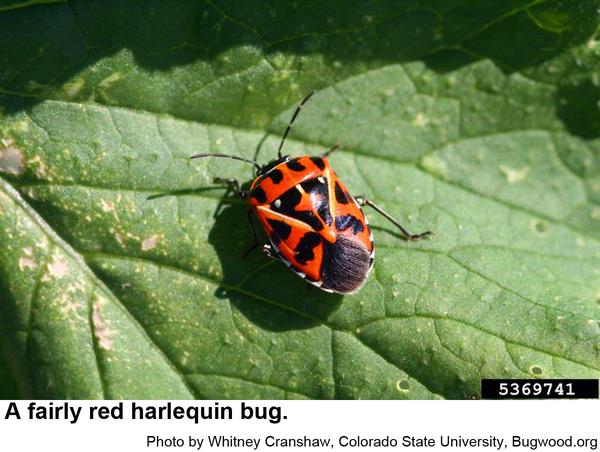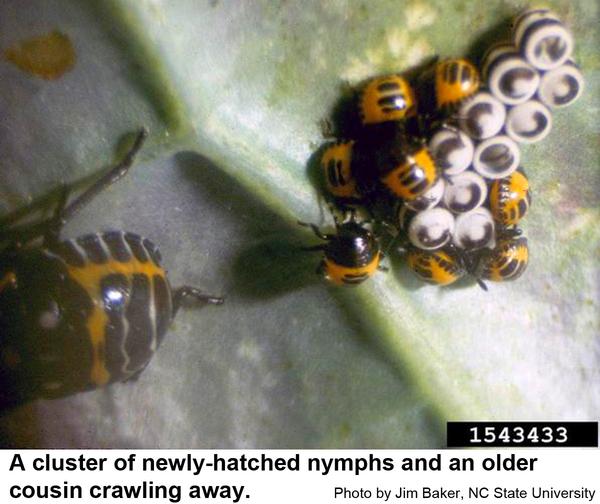Description and Biology
Harlequin bugs, Murgantia histrionica, are robust and black with vivid red, orange, or yellow markings. They are shield-shaped or oval in top view and 1/4 to 3/8 inch long. Females lay tiny, barrel-shaped eggs that are pale with two black bands. The top has a black circle or crescent shaped, and a tiny black spot occurs between the side bands. Eggs are laid in double-row clusters of 10 to 13 on the leaves of plants in the mustard family. Tiny nymphs are oval with bold marking. Older nymphs resemble adults but lack wings. Harlequin bugs overwinter as adults by hibernating among plant debris. Adults emerge early in spring and after 2 weeks, females begin depositing eggs on the undersides of leaves. Each female may deposit up to 155 eggs or so. In early spring, eggs hatch in about 20 days. Eggs hatch in 4 to 5 days as the weather becomes warmer. Nymphs feed for 6 to 8 weeks and develop through 5 stages before becoming adults. Two to four generations occur each year in North Carolina.
Host Plants
Harlequin bugs feed on cleome, flowering cabbage, ornamental kale, and stock (they can also be a problem in vegetable gardens). Harlequin bugs attack nearly all crucifers, including common weeds of the mustard family such as wild mustard, shepherdspurse, peppergrass, bittercress, and watercress. If infestations are heavy, harlequin bugs also feed on squash, corn, bean, asparagus, okra, and tomato. Adults and nymphs pierce stalks, leaves, and veins with their needle-like mouthparts and extract plant juices. Stems and leaves injured in this manner develop irregular cloudy spots around the puncture wound. Young plants are likely to wilt, turn brown, and may eventually die whereas older plants are only stunted.
Residential Recommendations
Harlequin bugs can be removed by hand and dropped into a container of soapy water to kill them. Should the amateur horticulturist be too squeamish to handle these bugs, insecticides labeled for residential use should give adequate control if applied according to the directions presented on the label of whichever pesticide is used. Don't apply pesticides to plants in flower to avoid killing pollinators.
Other Resources
- Common name: harlequin bug, scientific name: Murgantia histrionica (Hahn) (Insecta: Hemiptera: Pentatomidae). Knox, M. A. 2015 (revised). Featured Creatures, Entomology & Nematology, FDACS, DPI, EDIS. Publication Number: EENY-25
- Insect and Related Pests of Vegetables. Sorensen, K. A. and J. R. Baker eds. 1994. NC State Extension publication AG-295. 180 pp.
- NC State Extension Plant Pathology Publications
- NC State Horticultural Science Publications
- North Carolina Agricultural Chemicals Manual
For assistance with a specific problem, contact your local Cooperative Extension center.
This factsheet has not been peer reviewed.
Publication date: March 21, 2020
Revised: March 21, 2020
Recommendations for the use of agricultural chemicals are included in this publication as a convenience to the reader. The use of brand names and any mention or listing of commercial products or services in this publication does not imply endorsement by NC State University or N.C. A&T State University nor discrimination against similar products or services not mentioned. Individuals who use agricultural chemicals are responsible for ensuring that the intended use complies with current regulations and conforms to the product label. Be sure to obtain current information about usage regulations and examine a current product label before applying any chemical. For assistance, contact your local N.C. Cooperative Extension county center.
N.C. Cooperative Extension prohibits discrimination and harassment regardless of age, color, disability, family and marital status, gender identity, national origin, political beliefs, race, religion, sex (including pregnancy), sexual orientation and veteran status.





